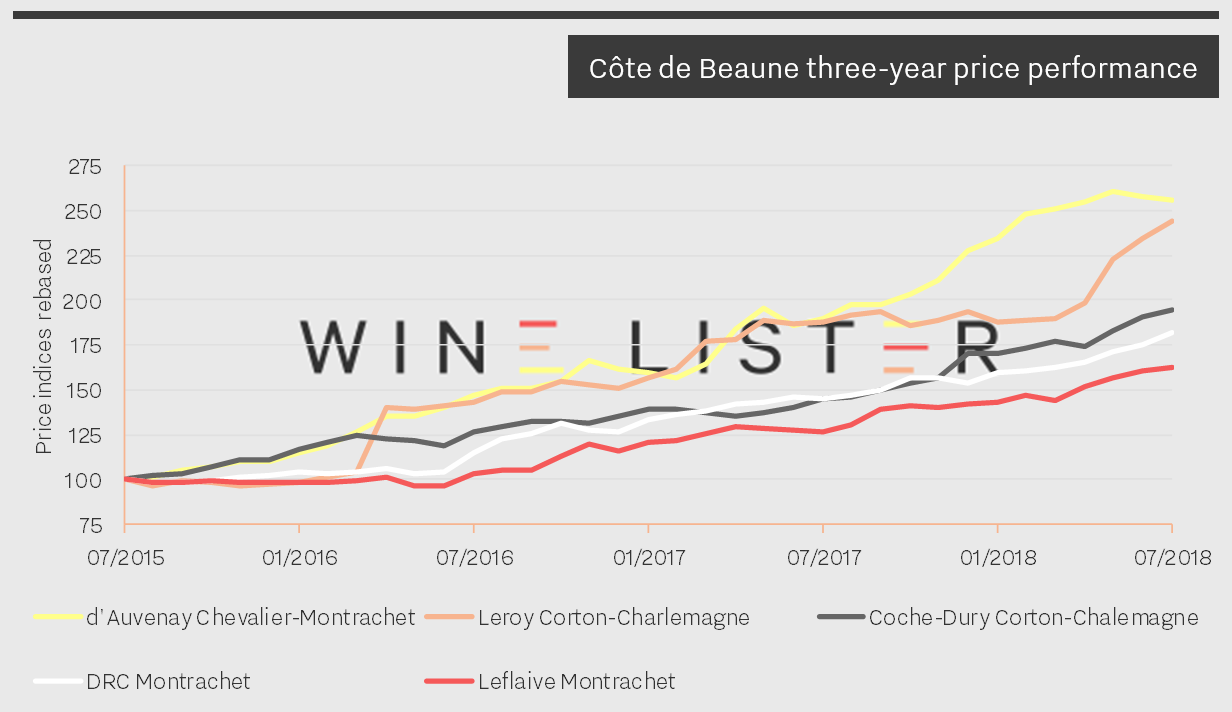Wine Lister recently looked at red Christmas drinking options with the best Bordeaux under £50, and now that the official ‘sparkling season’ is almost upon us, it is high time to consider options for holiday bubbles. Below we examine the all-round best of the best – the top five Grand Cru Champagnes by Wine Lister score.
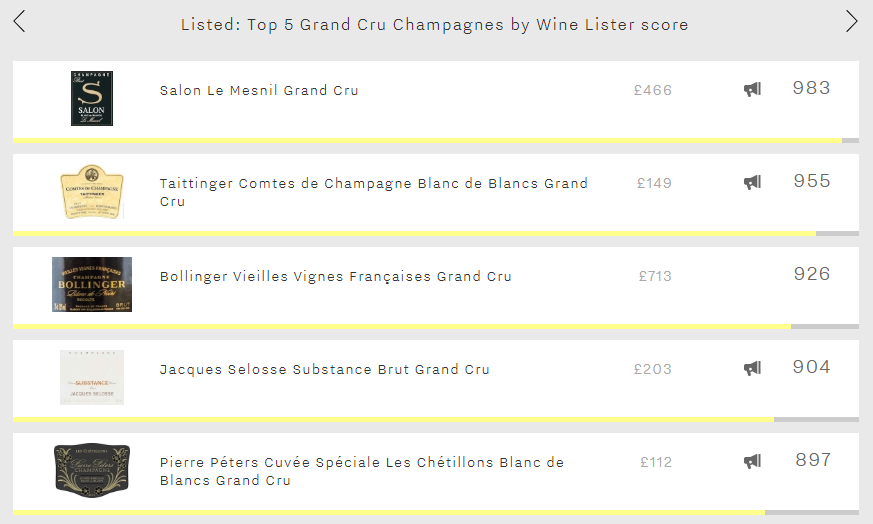
The number one Grand Cru Champagne is the indomitable Salon Le Mesnil (983). It fires on all Wine Lister cylinders, with impressive Quality, Brand, and Economics scores of 980, 989, and 981 respectively, meaning that it leads this week’s top five across each category. Moreover, it is the number one white wine on Wine Lister – still, sparkling, dry, or sweet. If you’re after a memorable bottle to kickstart the holiday season, then look no further than Salon 1996, its best ever vintage. As proof of the extraordinary longevity of top Champagne, the 1996 will be drinking well until at least 2025. Though expensive (£550 per bottle in-bond), you would be well-rewarded for paying the high price, Antonio Galloni calling the 1996 “the ultimate expression of Champagne as a wine”.
Next comes Taittinger’s Comtes de Champagne, whose main strength is its Brand score (976). This is helped by a production volume of c.170,000 bottles per annum – almost twice that of the other four Champagnes of this week’s group combined. It consequently also achieves the highest auction-trading volumes of the group, having traded 789 bottles over the past four quarters, according to our data partner, The Wine Market Journal.
In third place is Bollinger Vieilles Vignes Françaises. The term “vielles vignes” tends to get banded around quite frequently without much meaning, but in this case it carries rare significance. These old vines are planted on French rootstock, predating the spread of phylloxera which lead to the introduction of louse-resistant American rootstock onto the vast majority of France’s vines. As might be expected given the wine’s unique heritage, it comes with a hefty price tag (£713 per bottle in-bond). However, this rarity backs up its high price with an outstanding Quality score (963) – the joint-second best of this week’s top five.
In fourth place is Jacques Selosse’s Substance Brut (904). The only non-vintage wine of the five, it matches the Bollinger Vieilles Vignes Françaises’ excellent Quality score (963). Its outstanding quality, coupled with its tiny production volume of 2,700 bottles per annum, start to explain the £203 price-tag of this NV grower Champagne.
Finally, in fifth place, is Pierre Péters’ Cuvée Spéciale Les Chétillons Blanc (897). Though in fifth place, its impressive Quality (923) and Economics (922) scores suggest it could be a prime choice for cellaring. It achieves the best short and long-term price growth of this week’s top five, having added 16.7% to its price over the past six months, and recording a three-year compound annual growth rate (CAGR) of 36.5%. Any recent vintage would perhaps therefore be better placed under the Christmas tree (for an extremely lucky recipient), rather than on the Christmas table.
Thanks to tiny production quantities, exceptional quality, and increasing popularity, Burgundy tends to be expensive. In Wine Lister’s Burgundy Market Study (published in January this year), we analysed its rapidly-climbing prices. This week’s Listed blog focuses on the very tip of the Burgundy price hierarchy, with the top five by average price.
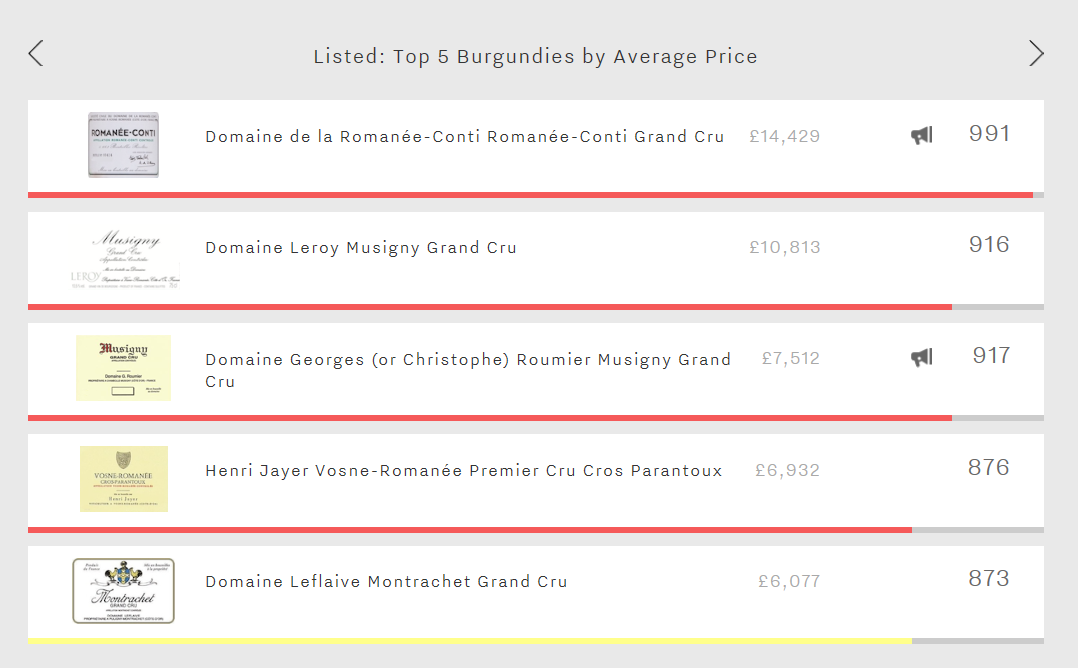
Four of this week’s top five hail from the Côte de Nuits, the first of which is, unsurprisingly, Domaine de la Romanée-Conti’s Romanée-Conti at an average price of £14,429 per bottle in-bond. The high price tag is accompanied by the best red Quality score on Wine Lister (993) and a Brand score of 989. The latter is achieved in part by being the 8th most-searched-for wine on Wine Lister (and indeed gains two and a half times as many monthly searches on Wine Searcher as the remaining wines of this week’s top five combined). Its most recent release – the 2015 vintage, receives a Quality score of 997, with Wine Lister partner critics Bettane + Desseauve and Jancis Robinson both awarding it 20/20. Even if the 2015 vintage is DRC Romanée-Conti’s best-performing in the last 15 years, its price increase of nearly 500% (from £2,925 to £17,496) since release in January is virtually incomprehensible.
In second place is one of two Musignys to feature this week. Domaine Leroy’s Musigny has an average in-bond price of £10,813 per bottle and a Quality score of 988 – just five points behind this week’s number one. Its overall Wine Lister score sits 75 points down from DRC Romanée-Conti, due to a more modest Brand score of 781. Interestingly, Leroy’s Musigny has been qualitatively more consistent over the past five releases than Wine Lister’s highest-quality red – its Quality score deviates a maximum of just one point from year to year since 2010 (compared to DRC Romanée-Conti’s maximum deviation of seven points).
Number three of this week’s top five is the second Musigny, this time from Domaine Georges Roumier. With a slightly lower price tag of £7,512 per bottle in-bond, and the second-highest Brand score of the group, Roumier is somewhat a darling of the trade – indeed, this Musigny is in the top 10% of most talked-about wines by the fine wine trade, according to Wine Lister’s Founding Member Surveys.
The last two spots are taken by wines that each stand alone among this week’s top five for their own reasons. The first, Henri Jayer’s Vosne-Romanée Cros Parantoux at £6,932 per bottle is the only Premier Cru to feature, as well as the only wine no longer in production.
Finally, Domaine Leflaive’s Montrachet Grand Cru is the only white of the group. As the most expensive white Burgundy on Wine Lister at £6,077 per bottle, it also earns white Burgundy’s highest Quality score of 985.
Wine Lister Indicators are designed to help you find the perfect fine wine for any occasion. Wine Lister regularly tracks the movements of wines in and out of these segments (such as recent commentary featuring new Buzz Brands for Burgundy). This month we look at newcomers to the Value Pick segment – wines that achieve the best quality to price ratio.
France is the geographical victor of new Value Picks, with a total of seven wines hailing from Bordeaux and the Rhône (and one from the Loire). These traditional regions may appear “uncool” compared with the likes of Burgundy (whose popularity continues to rise). However, it is perhaps thanks in part to their “uncool” status that Bordeaux and the Rhône are also sources of exceptional value for money.
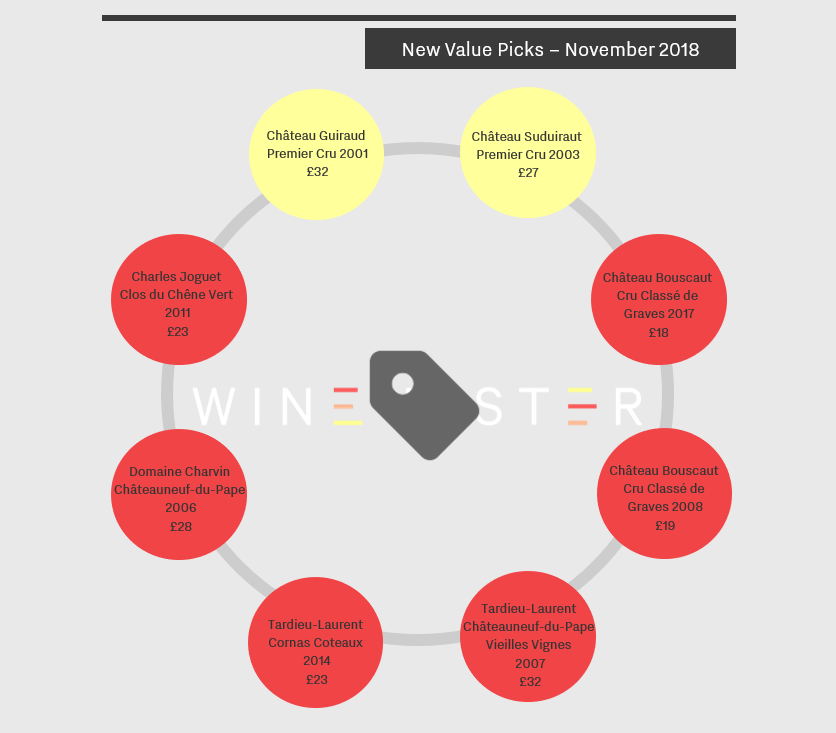
The only two whites of our new Value Picks, Château Guiraud Premier Cru 2001 and Château Suduiraut Premier Cru 2003, actually achieve the highest Quality scores of the group (936 and 929 respectively). Château Guiraud 2001 is priced at £32 per bottle in-bond, and Château Suduiraut 2003 at £27. Sadly, the incredible Quality scores of these Sauternes (as well as others across the board) may be hindered by a lack of demand for the volume produced. Sauternes typically earn poor Economics scores on Wine Lister (Château Guiraud 2001 achieves an Economics score of 212, and Château Suduiraut 2003 345), perhaps due to the pace at which older vintages of these exceptional sweet wines are consumed. With Christmas just around the corner, however, there is every reason to source either of these two for good value for your buck.
Elsewhere in Bordeaux, Pessac-Léognan rules the Value Pick reds with two listings from Château Bouscaut. The 2017 is one of Bouscaut’s new Value Pick vintages, however the real appeal, with 10 years of age, is the physical 2008 vintage, which achieves a Quality score of 768 (vs. 775 for 2017) for a price just £1 above the latest release (at £19 per bottle in-bond). These two vintages join existing Value Picks of Château Bouscaut, namely the 2016, 2015, 2013, and 2004. The latter is interestingly Bouscaut’s highest-scoring vintage ever (868), and therefore provides exceptional value at £21 per bottle in-bond.
In the Rhône, producer Tardieu-Laurent has two newcomers to the Value Pick segment: Châteauneuf-du-Pape Vieilles Vignes 2007 (£32) and Cornas Coteaux 2014 (£23), with Quality scores of 906 and 813 respectively. The Châteauneuf-du-Pape Vieilles Vignes now has an impressive six Value Pick vintages, and the Cornas Coteaux four. Indeed, Tardieu-Laurent (which was recently acquired by EPI, the owner of top Brunello producer Biondi-Santi and both Piper and Charles Heidsieck) appears a good producer to choose for value, with six of the domaine’s ten wines on Wine Lister having vintages in the Value Pick segment. It is perhaps therefore surprising that its Brand scores sit mostly in the average section of Wine Lister’s 1,000-point scale or below – uncool, but with very cool price to quality ratios.
A second Châteauneuf-du-Pape, the 2006 from Domaine Charvin is the third wine from the Rhône to make it to the list, with a Quality score of 869 and available at the modest price of £28 per bottle in-bond.
These French Value Picks convince us that “old-school” wines should not be dismissed as such. With an average price of £25 per bottle in-bond, and an average Quality score of 858, these represent excellent value for money – and that will always be cool.
This week some of the Wine Lister team attended the Institute of Masters of Wine‘s Annual Claret Tasting, which this year focused on Bordeaux’s 2014 vintage. Though still young, it is a vintage that is tasting beautifully.
Throughout Wine Lister’s coverage of this year’s en primeur campaign, we found ourselves referring frequently to the 2014 vintage for comparative (and sometimes better) quality, and crucially, better prices. Below we explore the vintage in more detail, looking at Quality and Economics scores by appellation. (Note that this analysis was produced based on the basket of wines represented at the IMW Tasting).
Wine Lister’s holistic and dynamic approach allows us to not only see which appellations produced the vintage’s best wines, but also demonstrates if and how the market has since reacted to each appellation’s relative quality.
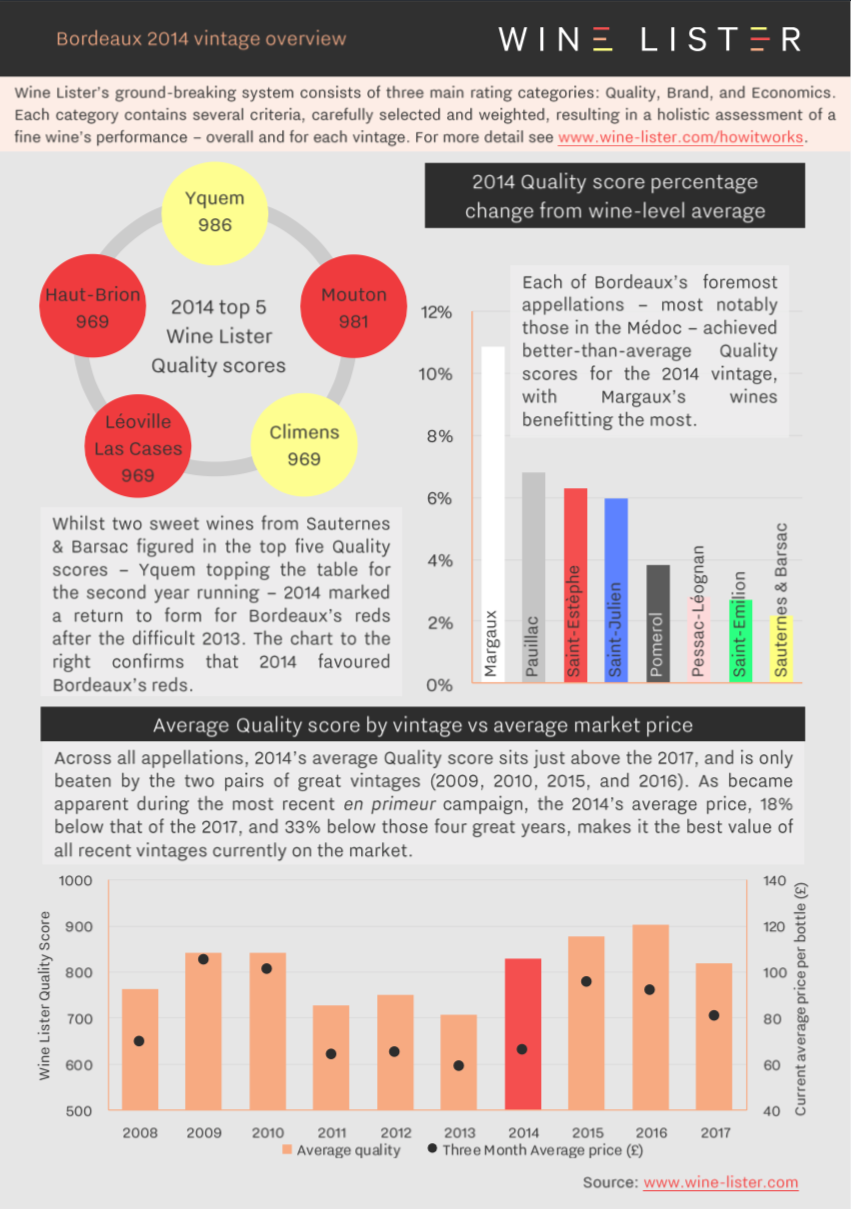
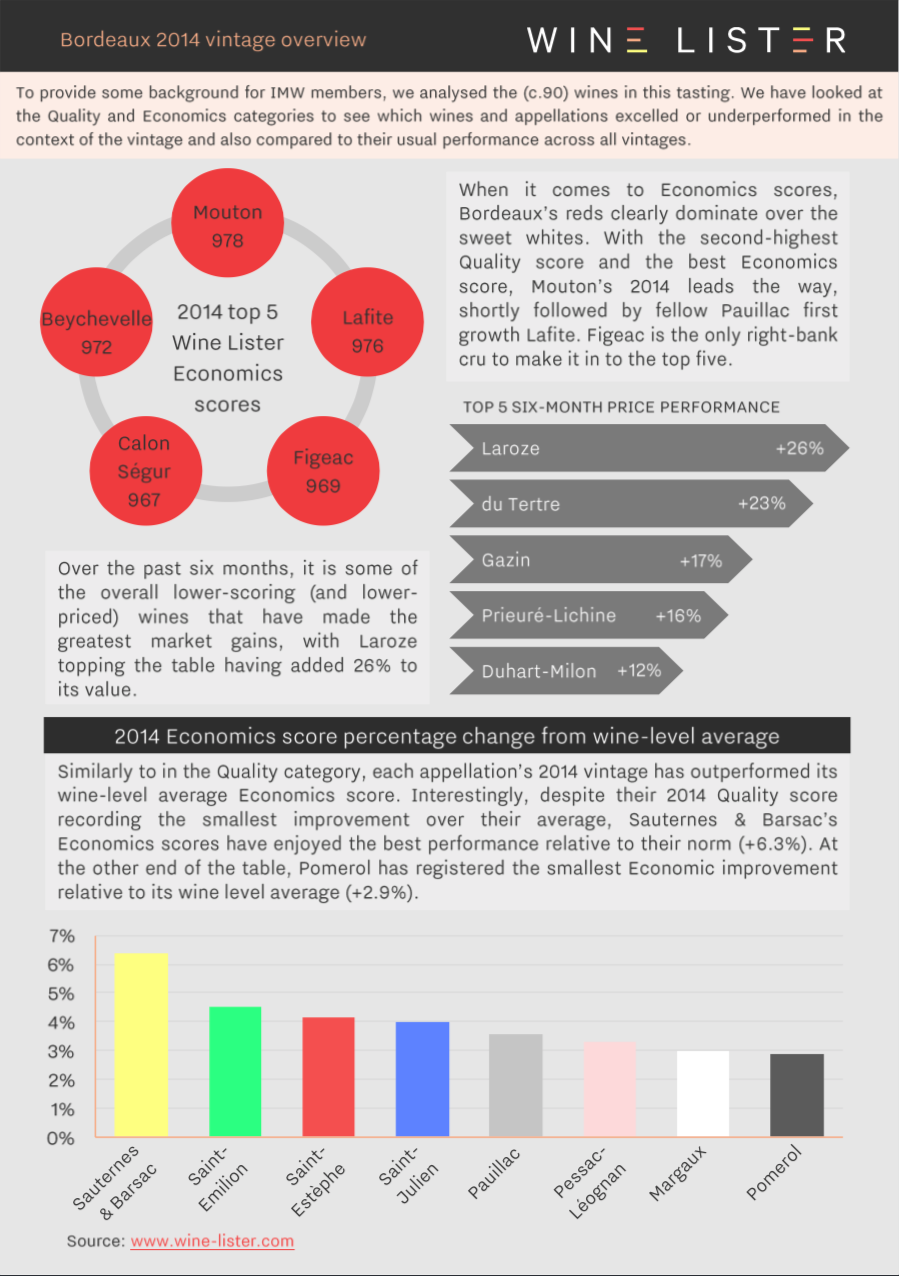
You can download the slide here: Wine Lister IMW 2014 vintage overview
Having dipped its toe in New World waters last week to look at Argentina’s best wines, the Listed blog now shifts its attention considerably further North, heading to the Alsace to consider its top five dry whites by Wine Lister score.
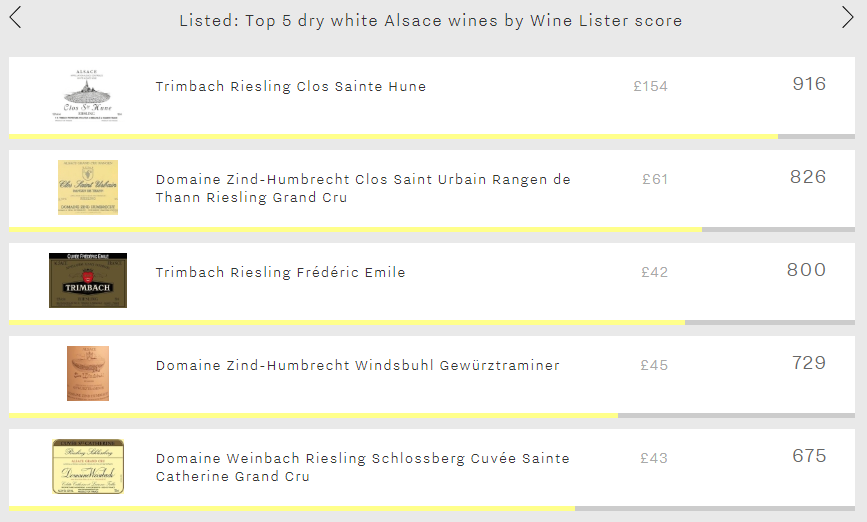
Whilst there was not much between Argentina’s top two wines, in the Alsace it is very much a case of the best and the rest, Trimbach’s flagship Clos Sainte Hune leading by 90 points with a score of 916. Its dominance is thanks to comfortable leads across each of Wine Lister’s rating categories. However, it is in terms of Economics that no other Alsatian wine can get close to it, its score of 804 nearly 120 points ahead of Zind-Humbrecht’s Clos Saint Urbain Rangen de Thann Riesling, whose score of 688 makes it the region’s number two wine in the commercial category. The Clos Sainte Hune’s economic clout is thanks to its higher price (over three times the average of the four other contenders to the Alsatian crown), and trading 2.6 times as many bottles at auction as the others over the past four quarters. As an aside, it is also by far the region’s most searched-for wine online, although its ranking as the 216th most popular wine on Wine Lister perhaps betrays a lack of public interest in Riesling and Alsatian wines in general. Sommeliers are more convinced however, with it featuring in 37% of the world’s top restaurants – which, interestingly, is not the best performance of any Alsatian wine. That accolade goes to its sibling Cuvée Frédéric Emile which manages to pip it to the post in this particular criterion (38%).
Trimbach isn’t the only producer to feature twice in this week’s top five, Zind-Humbrecht’s Clos Saint Urbain Rangen de Thann Riesling (826) and Windsbuhl Gewürztraminer (729) both making the cut. Despite being separated by nearly 100 points overall, they achieve similarly excellent Quality scores, the Clos Saint Urbain Rangen de Thann Riesling leading by just six points (916 vs 910). There isn’t that much between the two in terms of economic performance either, with the Windsbuhl Gewürztraminer sitting 47 points below its stablemate (641 vs 688). Thus the real difference occurs in the Brand category, with the Windsbuhl Gewürztraminer unable to keep pace either in terms of the number of restaurants in which it features (5% vs 16%) or search rank (2,070 vs 928), resulting in a considerably weaker score (546 vs 791). This perhaps confirms that Gewürztraminer, regardless of the quality in the bottle, is a grape that is currently unable to excite either sommeliers or consumers – Zind-Humbrechts’s Windsbuhl languishing in fifth place across both Brand criteria.
The final wine this week is Weinbach’s Riesling Schlossberg Cuvée Sainte Catherine (675). Confirming the outstanding Quality of the Alsace’s top wines, across all vintages it achieves a Quality score of 900. Its overall Wine Lister score is dragged down partly by a lower Brand score (661), but for the most part by a weak Economics score (191). However, if you’re looking for top Quality at a reasonable price, then look no further than its 2014, which qualifies as a Wine Lister Value Pick. Available for as little as £30 per bottle, yet with a Quality score of 944 and predicted to be drinking well for another 15 years, it would definitely be worth seeking out a few bottles of it.
It was with a heavy heart that the global fine wine trade learned of the passing of Barolo legend, Giuseppe Rinaldi, last week. Known for their elegant style and lengthy ageing potential, Rinaldi’s Barolos are not only some of the best that the region has to offer, but also some of the priciest.
In ‘Beppe’ Rinaldi’s honour, Wine Lister looks this week at the top five most expensive wines in Barolo. And there is good reason for these Barolos to be so pricey, with all of the five achieving a Quality score that falls into the “strongest” category on Wine Lister’s 1,000 point scale. On top of this, the first three qualify as Buzz Brands – Wine Lister’s group of wines that combine outstanding restaurant presence with online popularity.
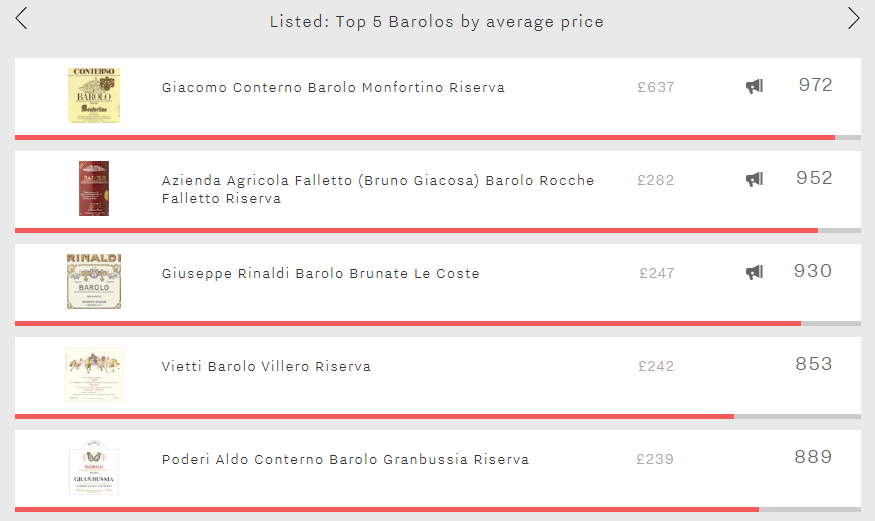
Giacomo Conterno’s Barolo Monfortino Riserva takes first place. At £637 per bottle it is more than twice the price of the rest of this week’s top five. In fact, it is the most expensive Italian wine on Wine Lister. However, it is no coincidence that Conterno’s Monfortino takes first place as it also achieves the group’s best Quality and Brand scores (977 and 969 respectively). Conterno Monfortino is actually the number one Italian wine and 11th best of all wines on Wine Lister, with an impressive overall score of 972.
This week’s second spot is occupied by Azienda Agricola Falletto (Bruno Giacosa) Barolo Rocche Falletto. Even though it competes well with Conterno Monfortino – with Quality and Brand scores of 974 and 914 respectively – it is a considerably cheaper option at £282 per bottle. In fact, despite its lower price, its Economics score is slightly superior to this week’s overall number one wine (969 vs 967), and is the group’s best. Furthermore, it is the second best of all Italian wines on Wine Lister – only beaten by Falletto’s Barbaresco Asili Riserva. The phenomenal Economics score is partly due to a three-year compound annual growth rate (CAGR) of 21.8%.
Giuseppe Rinaldi Barolo Brunate Le Coste takes third place at £247 per bottle. As perfect evidence of Rinaldi’s prowess, it is very consistent across each of Wine Lister’s three rating categories, with each score putting it amongst the very best wines in the world. Confirming its upward trajectory, it records a remarkable three-year CAGR of 36.7% – if it manages to keep that up, it will soon start to narrow the gap to Conterno’s Monfortino in this battle of the Barolos.
The two remaining wines in this group are not only very close in price but they also have the same Quality score (928). This week’s number four – at £242 per bottle – is Vietti Barolo Villero Riserva, followed closely by Poderi Aldo Conterno Barolo Granbussia Riserva at £239. Visible in 17% of the world’s top restaurants, Aldo Conterno’s Granbussia has the second-highest restaurant presence of the group. It is only beaten by this week’s number one, Conterno’s Monfortino, which is visible in 23% of top establishments.
While wines made in The Golden State are not as affected by vintage variation as their European counterparts, the 2013 vintage was for California as close to perfect as they come. The long, hot summer led to Cabernet Sauvignons with extreme fruit concentration and firm structure – a recipe for long-term cellaring. The vintage’s economic credentials seem equally promising, with Economics scores of the top five Californian reds from the 2013 vintage outperforming their respective wine-level average by 114 points (averaging 979 in 2013 versus 864 across all vintages).
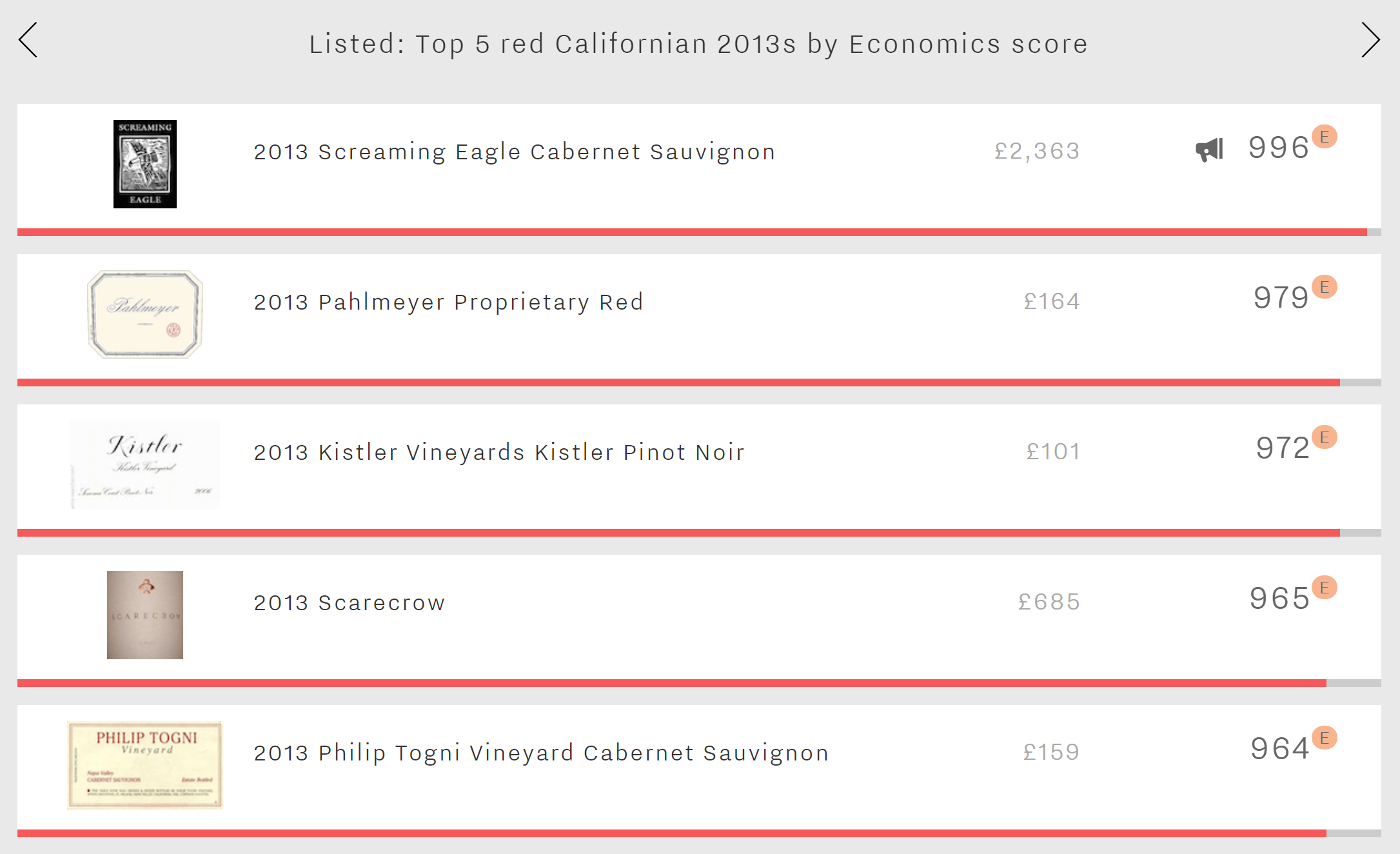
Perhaps unsurprisingly, the number one spot is taken by Screaming Eagle Cabernet Sauvignon. At 996, its Economics score is not only the highest of this week’s top five, but of all 2013s on Wine Lister (matched only by 2013 DRC Richebourg). It is also by far the most expensive of the five at £2,363 per bottle – over twice as high as the price of the other four combined. Screaming Eagle’s “mailing list” sales model teamed with tiny production quantities (7,800 bottles per annum on average) means that demand for this wine consistently outweighs supply. This could explain the wine’s strong presence on the secondary market, with 855 bottles traded at auction over the last 12 months (according to figures collated by the Wine Market Journal).
In second place is 2013 Pahlmeyer Proprietary Red. Interestingly, it has the lowest Quality score of the group. Indeed, its 2013 Quality score is 74 points lower than Pahlmeyer’s average (848). Contrastingly, the 2013 vintage receives its best ever Economics score of 979, boosted by a six-month price performance of 18.7%.
The third spot of this week’s top five is occupied by the only Pinot Noir of the group, Kistler Vineyards Pinot Noir, with an Economics score of 972. It is the only wine of the five to have been released before 2016, and thus the only one with a three-year compound annual growth rate (28.2%), whereas Economics scores for the other four 2013s are based upon price performance over the short term only. Kistler’s place in the top five 2013 Californian reds by Economics score is impressive, given its lower price point (£101 per bottle, compared with an £843 average for the other four wines).
The penultimate wine of this week’s top five is 2013 Scarecrow. Alongside its best ever Quality score (987), the 2013 vintage achieves an Economics score of 965, helped by the second-highest three-month average price (£663) and the best price stability of the group (with standard deviation of just 4.1% over the last 12 months).
Last but by no means least is Philip Togni Vineyard Cabernet Sauvignon, with an Economics score of 964. Though fifth for economics, it is number one for Quality, thanks to a 100-point score from Wine Lister partner critic, Antonio Galloni, who calls it “a majestic, towering wine… one of the wines of the vintage”.
A glass of cold Riesling on a hot summer’s day hits that sweet spot between refreshment, satisfaction, and intrigue. Any one of Germany’s finest wines for Quality under £300 would definitely deliver those three things. Moreover, with an average drinking window of 16 years, and with global warming seemingly set to deliver increasingly high summer temperatures, stock up on them now and you will be rewarded with stunning wines for years to come.

It is perhaps revealing of Riesling’s under-the-radar nature that three of this week’s top five qualify as Hidden Gems, meaning that they combine excellent critics’ ratings with modest restaurant presence and online popularity. Moreover, many of Wine Lister’s Hidden Gems were picked out by the global fine wine trade in our Founding Members’ survey, underlining the perennial mystery of Riesling as the darling of the trade, despite struggling to spark wide-scale consumer demand. Interestingly the group’s three Hidden Gems are all Beerenausleses (BAs). Schloss Johannisberg Rosa-Goldlack, Fritz Haag Brauneberger Juffer Sonnenuhr, and Weingut Robert Weil Kiedricher Gräfenberg’s BAs, in spite of a phenomenal average Quality score of 969, achieve an average Brand score of just 398 – the result of being present in just 2% of the world’s top restaurants and receiving only 70 online searches each month on average. Demand for excellent sweet Riesling is clearly not there at present.
However, returning to the group’s fantastic quality, it is Egon Müller’s Scharzhofberger Riesling Auslese that comes out on top with a score of 974. 2014 was its best ever vintage, with one of JancisRobinson.com’s critics, Michael Schmidt, awarding it 19/20 and heaping on the praise: “Our sensory perception is treated to an animating exuberance of exotic fruit and fresh raisins. Botrytis has been kept in check to focus on purity of expression rather than indulge in unctuous combustion”.
The group’s final spot is filled by Keller Westhofen Abtserde Riesling Grosses Gewächs (966). It is Jancis Robinson’s favourite of the five, achieving an outstanding average rating of 18.5/20 from Wine Lister’s UK partner critic. Tellingly, particularly in the context of the three BA’s lack of consumer demand, it is also the group’s most popular wine, receiving nearly 30 times more searches each month on average than the BAs. Consumers appear much more at ease with Riesling’s dryer styles.
Buzz Brands are wines that are sure to turn heads, destined to cause a stir whenever they are opened. They combine excellence across Wine Lister’s two Brand criteria – restaurant presence and online popularity – whilst also being held in the highest regard by the fine wine trade – as confirmed by Wine Lister’s Founding Members’ survey which gathers the opinions of around 50 key players in the international wine trade. This week, the Listed section focuses on Italy’s top five Buzz Brands by overall Wine Lister score.
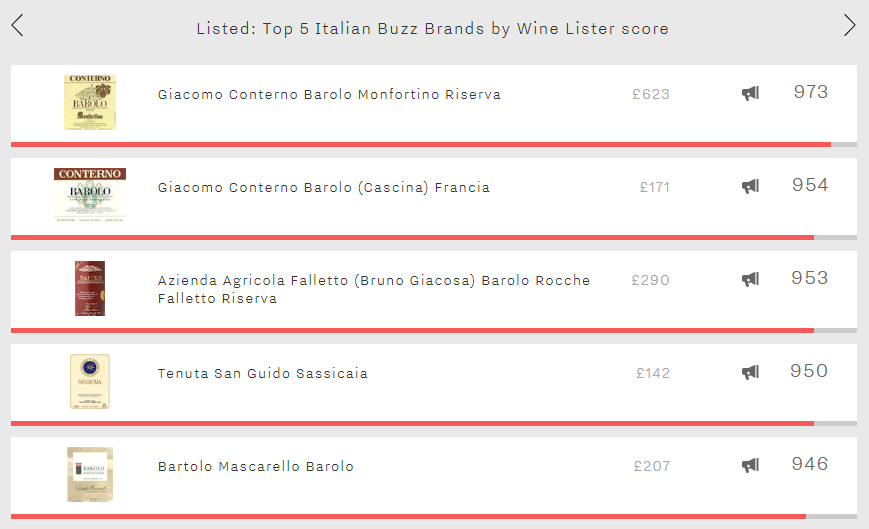
Barolo is home to four of Italy’s top five Buzz Brands, two of which are produced by Giacomo Conterno – the flagship Monfortino in first place (973) and Francia not far behind in second place (954). The Monfortino achieves Italy’s best Quality score (977), the result of remarkable consistency from vintage to vintage, having achieved a score of 993 or above in seven of the past 10 vintages. Its best ever vintage was 2004 (998), thanks to a perfect 100-point score from Antonio Galloni, who writes: “I imagine the 2004 Monfortino will give readers an utterly spellbinding drinking experience for the next few decades”.
Whilst the Francia is pipped at the post in each category by its illustrious stablemate (trailing by 17 points in the Quality category, 11 in the Brand category, and 34 in terms of Economics), it does manage superior restaurant presence, visible in 30% of the world’s top establishments, compared to the Monfortino’s 23%. This is presumably due to over three times as many bottles of it being produced each year on average.
In third place is Azienda Agricola Falletto’s Rocche Falletto Riserva (953). It records the best Economics score of the five (969) and Italy’s second-best, beaten only by Falletto’s Barbaresco Asili Riserva (978). It does so thanks to the combination of very strong growth rates – it has recorded a three-year compound annual growth rate of 21% and has added 8% to its value over the past six months alone – and strong liquidity – its top five vintages having traded 398 bottles at auction over the past year. Perhaps collectors have been eager to get their hands on a bottle after the passing of Bruno Giacosa in January.
Proving that Super Tuscans can mix it with Piedmont’s top nebbiolos, Sassicaia takes fourth place. Whilst it cannot keep pace with Barolo’s finest in the Quality and Economics categories, Sassicaia stretches out a comfortable lead in the Brand category thanks to an extraordinary score of 998. This near-perfect score puts it alongside Haut-Brion, Margaux, and Petrus, beaten only by the Pauillac First Growths, Dom Pérignon Vintage Brut, and Yquem. Its brand dominance is the result of outstanding restaurant presence (49%) and online popularity – receiving well over three times as many searches each month as Conterno’s Monfortino, which is the group’s second-most popular wine.
Rounding out the five is Bartolo Mascarello’s Barolo. Its brand is its strongest asset, its score of 964 making it Barolo’s second-strongest brand behind Conterno’s Monfortino. Despite receiving over 20% fewer online searches each month than the Monfortino, it matches its level of restaurant presence – perhaps the azienda’s famous “no barrique no Berlusconi” message strikes a chord with sommeliers.
This week’s Listed blog will for most be an exercise in window shopping (or perhaps lèche-vitrine might be more appropriate). Not just the eye-watering prices, but also the extreme rarity of this week’s top five – just 500 bottles of d’Auvenay’s Chevalier-Montrachet are produced each year – act as bouncers stopping all but the most fortunate from entering this exclusive Burgundian showroom. Nevertheless, we can at least vicariously get as close to Chardonnay nirvana as possible with the Côte de Beaune’s five most expensive wines.
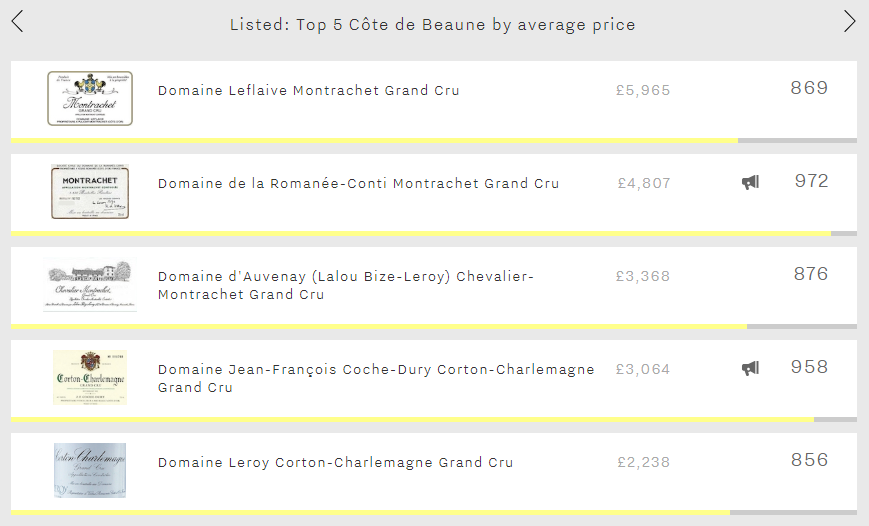
And these five really do get close to Chardonnay perfection, with a remarkable average Quality score of 975, putting them all amongst the top 15 still dry whites for Quality on Wine Lister. Perhaps reassuringly, Leflaive’s Montrachet, the Côte de Beaune’s most expensive wine, achieves the group’s best Quality score (985). 2010 was its best ever vintage, with a Quality score of 990, Jancis Robinson awarding it 19.5/20 and calling it: “[…] Not rich but gorgeous. Pale gold and obviously much fuller and deeper than Leflaive’s other grands crus. Rich yet so fresh! Nutty. Amazing concentrated fruit has already triumphed over the new oak. Very racy […]”. Interestingly, at £4,400 per bottle the 2010 is currently priced below all recent vintages other than the 2003.
Descending from the dizziest of heights, in second place is DRC’s Montrachet (£4,807). It is not just the Côte de Beaune’s overall top-scoring wine, but the best still dry white on Wine Lister (972). It is remarkably consistent across each of Wine Lister’s three rating categories, with Quality, Brand, and Economics scores of 975, 960, and 987 respectively. It is its Brand score that helps it nudge ahead in this Côte de Beaune showdown, with Coche-Dury’s Corton-Charlemagne the only one of the group to get close (924), the other three lagging c.250-290 points behind. Its brand superiority is the result of dominating both in terms of restaurant presence (visible in 26% of the world’s best establishments, comfortably above the Coche-Dury’s 19%) and online popularity (receiving 65% more searches each month than the Coche-Dury).
Whilst the Coche-Dury can’t quite match DRC’S Montrachet in the Brand or Quality categories, it does achieve the same phenomenal Economics score (987), having registered a superior three-year compound annual growth rate (25% vs 22%) and being the most-traded of the group at auction.
Lalou Bize-Leroy features twice in the list, first with d’Auvenay’s Chevalier-Montrachet (£3,368) and secondly with Domaine Leroy’s Corton-Charlemagne (£2,238). If ever there was proof of the life-altering potential of these hallowed wines, of his first taste of d’Auvenay’s Chevalier-Montrachet 1996, Wine Lister’s newest partner critic Neal Martin writes: “I took a large sip. It was like a thunderbolt hitting my senses: the tension, the complexity and intensity sent shivers down my spine. It was difficult to put down in words, yet this wine became instantly and indelibly etched onto my brain. Now I understood why oenophiles genuflected at the altar of white Burgundy”. With the d’Auvenay achieving a three-year compound annual growth rate of 45% and having added 18% to its value over the past six months alone, experiences such as Martin’s are only getting further out of reach for most.
The d’Auvenay is not alone in its soaring prices. As the chart below shows, demand for all of this week’s top five has skyrocketed over the past three years, each having added at least 62% to its value since July 2015. It seems the majority of us will have to satisfy ourselves with window-shopping for a little while longer.
